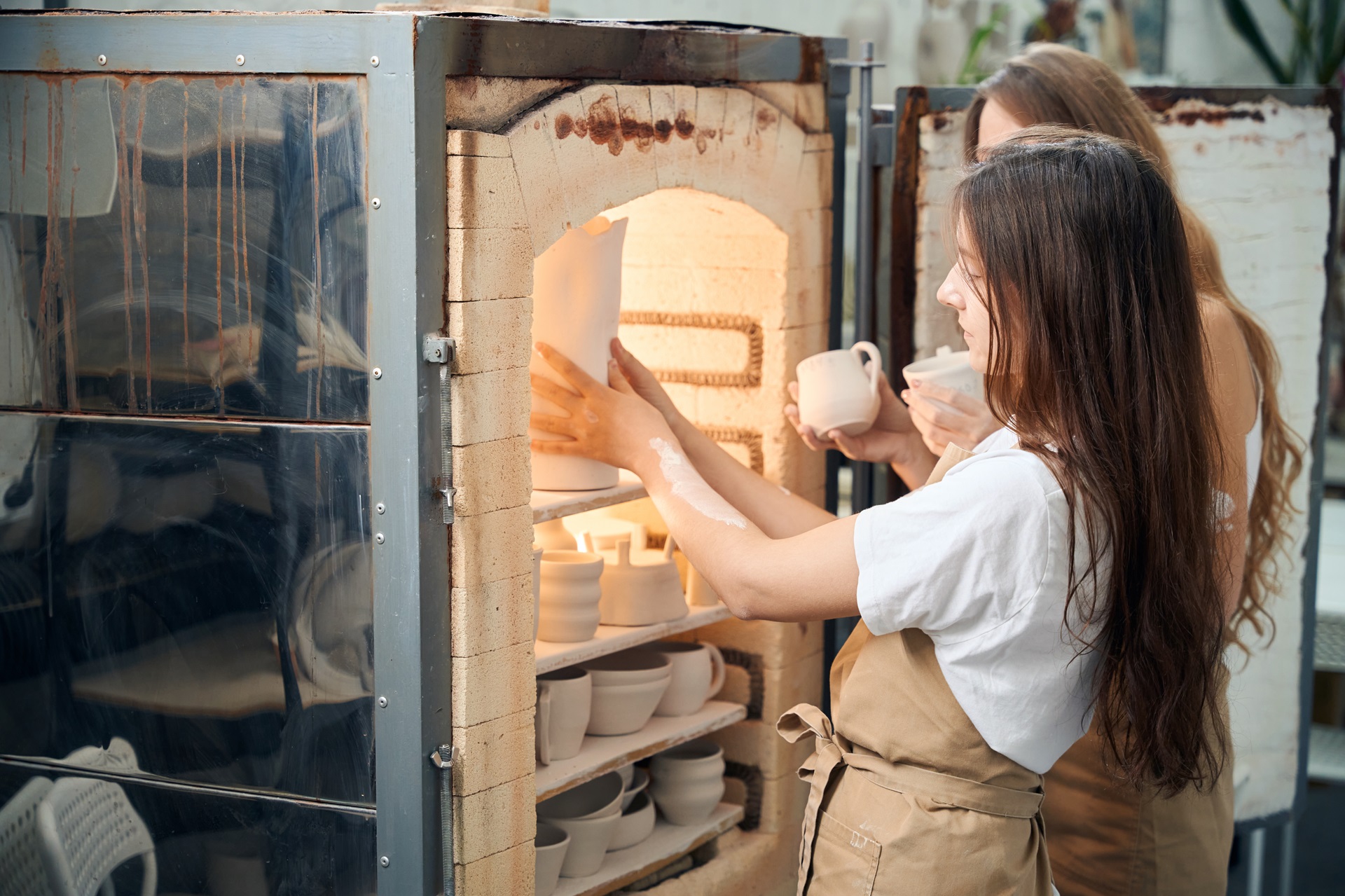The firing process is a critical stage in pottery making that transforms raw clay into durable ceramic pieces. It’s through firing that the magic of pottery making truly comes to life, as the heat binds the clay particles together, hardening the material and bringing out the vibrant colours of glazes. Understanding this process is essential for achieving the desired results in your pottery projects.
In our pottery making classes in Adelaide, we delve deeply into the firing process to help you master this crucial step. It’s not just about making your pottery strong and functional; firing also plays a significant role in the appearance and texture of your finished piece. By gaining a thorough understanding of how firing works, what types of kilns to use, and the suitable temperatures for different clays, you can take your pottery creations to the next level.
Our goal is to demystify the firing process for you. This includes explaining the different stages of firing, the various types of kilns available, the impact of firing temperatures, and practical tips for avoiding common pitfalls. Whether you’re a beginner or an experienced potter, knowing the ins and outs of firing will enhance your pottery making journey and lead to more successful and satisfying outcomes.
The Basics of the Firing Process
The firing process in pottery making serves the essential purpose of transforming raw, workable clay into a strong, durable ceramic object. This transformation is achieved through high temperatures that cause the clay particles to harden and bond together. Firing also plays a crucial role in setting glazes, ensuring they adhere properly to the clay and develop their intended colours and textures.
There are generally two main stages in the firing process: bisque firing and glaze firing. Bisque firing is the first stage, where the clay piece is heated at a moderate temperature to drive out physical water and organic matter, making it easier to handle and less likely to break when applying glaze. During this stage, the clay remains porous, which allows it to absorb the glaze more effectively. The second stage, glaze firing, involves heating the bisque-fired piece to a higher temperature, enabling the glaze to melt and form a glassy surface. This final stage locks the glaze in place and completes the transformation from a clay object to a finished ceramic piece.

Types of Kilns and Their Uses
Different types of kilns serve various purposes, each offering unique advantages and challenges. The three most common types of kilns are electric, gas, and wood-fired kilns.
Electric kilns are popular for their ease of use and consistent results. They are controlled electronically, which allows precise regulation of temperature. This makes electric kilns suitable for both bisque and glaze firing. They are generally safer and more convenient, especially in urban settings like Adelaide, where space and ventilation can be concerns. However, electric kilns can be limited in terms of the variety of effects they produce compared to other kiln types.
Gas kilns, on the other hand, use natural gas or propane as a fuel source. They provide greater flexibility in terms of atmosphere control, meaning you can create either an oxidation or reduction atmosphere. This ability to manipulate the kiln atmosphere allows for a wider range of finishes and effects on the pottery. However, gas kilns require more technical expertise to operate safely and effectively, and they also need proper ventilation.
Wood-fired kilns are traditional and offer unique and unpredictable results that many potters find exciting. The ash from the wood can interact with the glazes, creating natural variations and textures that cannot be replicated with other kiln types. However, wood-fired kilns demand a significant amount of time and labour, from chopping and stacking wood to tending the fire for many hours. They are also less environmentally friendly and require ample space and ventilation.
Choosing the right kiln depends on your specific needs, expertise, and available resources. Each type of kiln can significantly impact your pottery making experience and the final outcome of your pieces.
Understanding Firing Temperatures and Their Effects
Different clays require different firing temperatures to achieve the best results. The temperature at which clay is fired has a significant impact on its strength, colour, and overall finish. Low-fire clays, such as earthenware, are typically fired at temperatures between 950°C and 1,100°C. These clays are easier to work with and have bright, vibrant glaze colours, but they are less durable compared to high-fire clays.
Stoneware clays are usually fired at mid-range temperatures of 1,200°C to 1,300°C. These clays are known for their durability and versatility, making them a popular choice for functional pottery. They can withstand higher temperatures and are less porous than earthenware, which makes them suitable for items like mugs and bowls.
Porcelain is a high-fire clay that is typically fired at temperatures between 1,300°C and 1,450°C. Porcelain is highly valued for its strength, translucency, and delicate appearance. The high firing temperature vitrifies the clay, making it glass-like and highly durable. However, porcelain can be more challenging to work with due to its fine grain and high shrinkage rate during firing.
Firing temperatures not only affect the clay body but also influence the glaze applied to the piece. Different glazes mature at different temperatures, and firing too high or too low can result in undesired effects such as crazing, blistering, or dull colours. Understanding the relationship between firing temperatures and clay types is crucial for achieving the desired results in your pottery making projects.
Tips for Successful Firing
Achieving successful firing results in pottery making requires careful preparation and attention to detail. Here are some practical tips to help ensure your pieces come out perfectly:
1. Know Your Kiln: Familiarise yourself with the specific characteristics and settings of your kiln. Each kiln may have slightly different temperature controls and firing schedules, so it’s important to understand how yours operates.
2. Use Proper Support: Ensure that your pottery pieces are properly supported during firing. Use kiln stilts, shelves, and setters to prevent warping and allow even heat distribution.
3. Ventilation: Proper ventilation is crucial, particularly when using gas or wood-fired kilns. Ensure your workspace is well-ventilated to avoid harmful fumes and ensure consistent temperature.
4. Ramp Up Slowly: Gradually increase the kiln temperature to avoid thermal shock, which can cause cracking. A slow and steady heat rise allows the clay to adjust smoothly to the changing temperatures.
5. Monitor the Process: Keep a close eye on the firing process. Use pyrometric cones to gauge the kiln’s temperature accurately, and make adjustments as needed.
Common issues during firing include cracking, uneven glaze application, and kiln wash sticking to the base of your pottery. To troubleshoot these problems, check for even distribution of glaze and ensure your kiln shelves are properly coated with kiln wash. If cracks are frequent, examine your drying techniques, as uneven drying can weaken the clay before firing.
Conclusion
Understanding the firing process is essential for any pottery maker in Adelaide. From selecting the right type of kiln to mastering firing temperatures and troubleshooting common issues, each step plays a vital role in achieving beautiful and durable ceramic pieces. The firing process can seem complex, but with knowledge and practice, it becomes an exciting part of your pottery making journey.
At The Potters Shed, we’re dedicated to helping you master every aspect of pottery making, including the firing process. Join us for our pottery classes in Adelaide and take your skills to the next level, while enjoying the camaraderie of fellow pottery enthusiasts. Discover the joy of transforming raw clay into stunning works of art with expert guidance and support. Visit The Potters Shed today and ignite your passion for pottery making!

